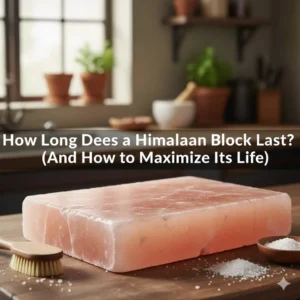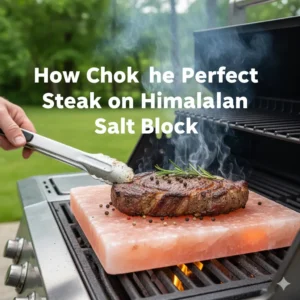Himalayan salt blocks are solid slabs of pink salt mined from ancient deposits in Pakistan’s Khewra region. In professional kitchens, they serve as durable, food-safe surfaces for grilling, searing, or chilling, subtly seasoning ingredients while enhancing visual presentation. For chefs and restaurant operators, these blocks offer a practical way to improve flavor consistency and create memorable plating experiences. This guide explains how to use, maintain, and integrate Himalayan salt blocks effectively in commercial food service.
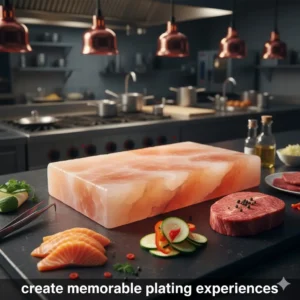
Prerequisites: Tools and Materials Needed
Before introducing Himalayan salt blocks into a commercial kitchen, chefs should organize the right tools to ensure safe handling and consistent results. Each item below supports controlled heating, effective cooking, and proper maintenance—reducing breakage risk while improving presentation standards.
| Item | Description | Notes |
|---|---|---|
| Himalayan Salt Block | Food‑grade blocks sourced from Pakistan’s Khewra Salt Mine, suitable for both cooking and plating applications. | Available in multiple sizes; typically weighs 8–20 lbs for commercial use. |
| Heat Source | A commercial oven, grill, or stovetop capable of gradual, controlled heating. | Equipment must allow slow, steady temperature increases to prevent cracking. |
| Infrared Thermometer | Monitors surface temperature to verify even heating and prevent thermal shock. | Ensures accuracy and consistency when using multiple salt blocks simultaneously. |
| Soft Cloth or Brush | Used for cleaning cooled blocks and maintaining hygiene between uses. | Avoid soap or water immersion to preserve the block’s surface integrity. |
| Trivet or Heat‑Resistant Surface | Holds heated blocks securely while protecting countertops and plating stations. | Essential for table‑side service and safe handling in high‑volume environments. |
Equipping the kitchen with these materials enables chefs to manage block temperature safely, uphold food safety standards, and extend product life—all critical for consistent menu performance and cost control.
Preparing and Heating Himalayan Salt Blocks
Himalayan salt blocks combine durability and distinctive presentation in a professional kitchen. To keep them performing consistently, chefs must manage the heating process with precision. Every stage—from tempering to preheating—affects both longevity and cooking quality. The following steps outline reliable methods that allow food service teams to use salt blocks safely and efficiently in daily operations.
Step 1: Temper the Salt Block Gradually
Tempering removes internal moisture and stabilizes the block before it’s exposed to high heat. This process is vital in kitchens where salt blocks are used often. Place the block in a cold oven or grill and increase the temperature slowly—from about 100 °C up to approximately 500 °C over several hours. Avoid rapid heating, which can cause thermal shock and cracking. After reaching the final temperature, let the block cool gradually in place. Never immerse a hot block in water or set it on a cold surface, as sudden changes compromise its structure.
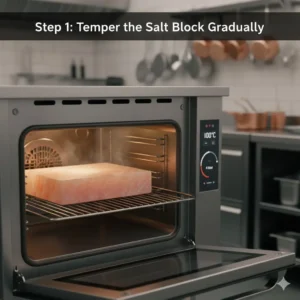
Step 2: Preheat and Check for Cooking Readiness
After tempering, controlled preheating ensures consistent performance during service. Warm the block gradually on the cooking surface, using an infrared thermometer to verify even heat distribution. A drop of water that sizzles and evaporates instantly indicates readiness for searing. Steady heating aligns with kitchen pacing and prevents uneven temperature zones that shorten block life. When integrated into regular workflow, these practices uphold quality, safety, and operational efficiency.
Premium Himalayan Salt Blocks for Culinary & Hospitality
Partner with Jilin Ever Creation for authentic, food-grade Himalayan salt blocks sourced from Pakistan’s Khewra Salt Mine. Perfect for grilling, searing, or chilling, our customizable salt products add natural flavor and elegance to your menu or retail lineup, with flexible order sizes and global shipping.
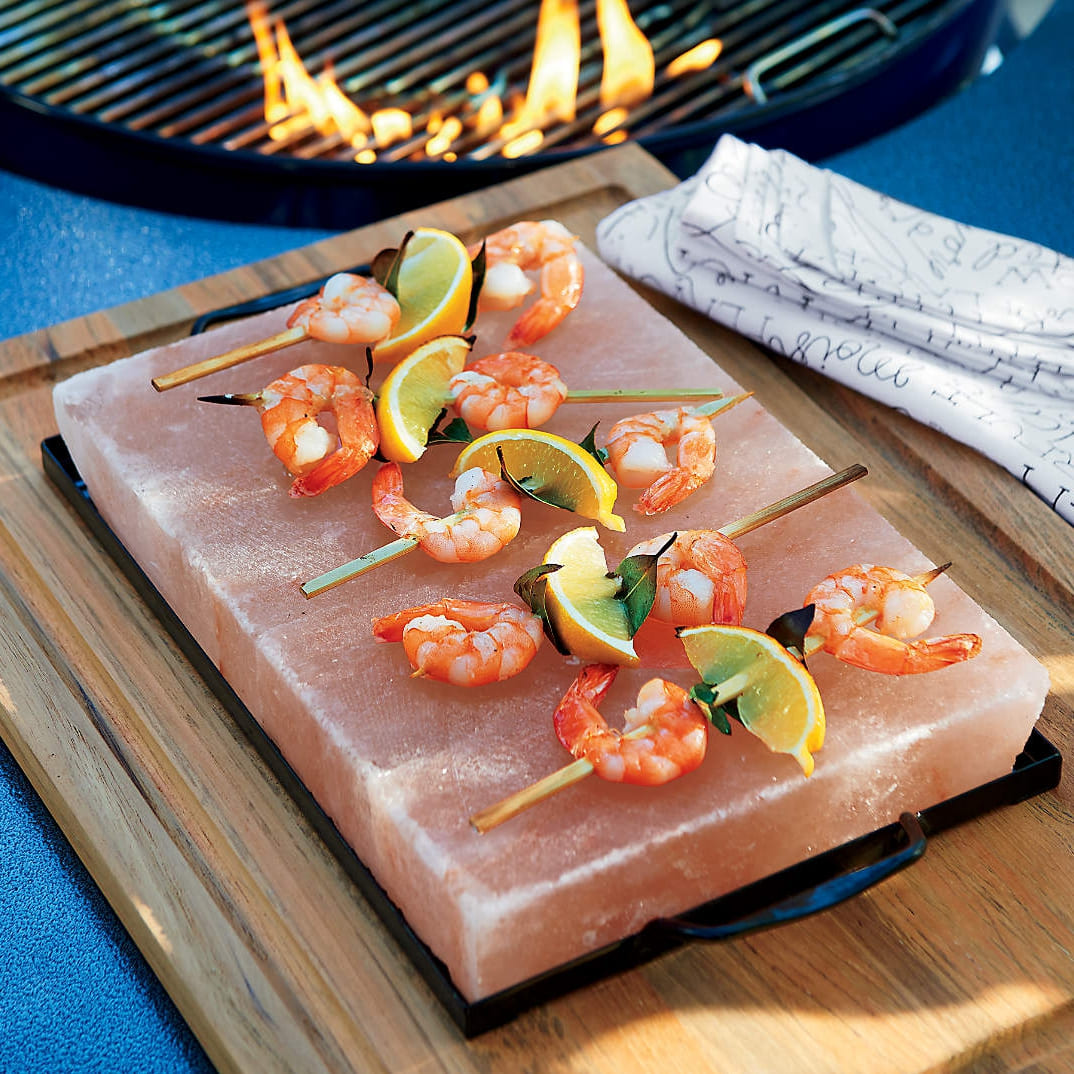
Integrating Salt Blocks into Professional Kitchen Workflows
Bringing Himalayan salt blocks into restaurant operations requires structured planning to preserve both efficiency and product integrity. These blocks should be managed as consumable culinary tools—heated gradually, rotated regularly, and replaced on schedule. When handled correctly, they elevate cooking performance and presentation without interrupting service flow.
Organize heating cycles in staggered intervals so that a preheated block is always available for immediate use. This rotation reduces downtime and maintains consistency during high-volume service. Following manufacturer instructions for preheating and cooling prevents thermal shock, protecting both equipment and food quality.
During peak hours, assign a dedicated team member to oversee salt block heating, cleaning, and rotation. Centralizing this responsibility ensures temperature control, safe handling, and timely replacement. Routine monitoring also provides data for tracking wear and aligning replacement costs with overall menu profitability.
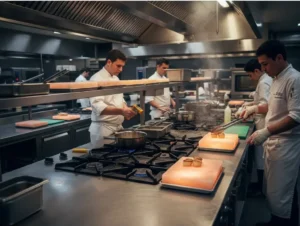
Durability and Lifespan of Himalayan Salt Blocks in Restaurants
In commercial kitchens, Himalayan salt blocks act as consumable tools rather than long-term equipment. Their durability depends on consistent, careful handling during both cooking and cleaning. Gradual heating and proper tempering strengthen the crystalline structure, helping it withstand temperature changes and resist cracking over time.
In high-volume operations, frequent heating and cooling cycles naturally reduce a block’s lifespan—especially with intensive searing or tableside service. In most food service environments, a block remains usable for several weeks to a few months, depending on heat exposure and workload. Treating it as a recurring cost within kitchen budgeting ensures steady quality without sudden equipment losses.
Routine inspection is essential for maintaining both safety and presentation standards. Chefs should evaluate each block after service for chips or cracks, since irregular surfaces can lead to uneven cooking or sanitation issues. With proper maintenance and periodic replacement, Himalayan salt blocks deliver consistent performance, flavor enhancement, and striking visual appeal on the menu.
Cleaning and Food Safety Best Practices
Proper cleaning and storage preserve both safety and performance when using Himalayan salt blocks in professional kitchens. After cooking, always allow the block to cool completely to room temperature before cleaning—this prevents cracking caused by thermal shock. Once cooled, gently remove food residue with a dry cloth or soft brush to maintain a smooth, sanitary surface.
Because salt dissolves easily in water, never soak the block, place it in a dishwasher, or apply soap. Moisture erodes the surface and reduces the block’s lifespan. Keeping it completely dry between uses prevents bacterial buildup and maintains seasoning purity for future service.
Store cooled salt blocks in a cool, dry space away from humidity or steam. Position them on a rack or trivet to allow airflow on all sides. Consistently following these steps preserves the block’s natural antimicrobial properties and upholds the food safety standards expected in commercial kitchens.
Menu Development and Profitability with Salt Block Cooking
Serving dishes on Himalayan salt blocks allows restaurants to blend functionality with refined presentation. Chefs can sear seafood, grill vegetables, or showcase chilled items such as sushi directly on the block, creating a distinctive experience that enhances both flavor and visual appeal. In a professional kitchen, this method aligns naturally with premium dining standards where sensory impact and consistency are priorities.
When planning menus, treat salt blocks as consumable assets rather than permanent equipment. Their cost should be included in recipe calculations, similar to oils or specialty seasonings. Budgeting for regular replacement keeps pricing transparent, safeguards margins, and supports predictable cost management even as the presentation drives guest interest.
Tableside preparation further amplifies value perception. Watching a chef finish scallops or steak on a sizzling salt block conveys skill and authenticity, reinforcing a sense of craftsmanship that justifies premium pricing. This interactive approach strengthens the dining experience while positioning the restaurant as detail‑oriented and innovative.
Frequently Asked Questions About Restaurant Salt Block Use
How long does a Himalayan salt block last in professional kitchen use?
In commercial applications, Himalayan salt blocks are consumable assets. With consistent use for cooking or plating, they typically last a few months before thinning, cracking, or losing structure. Including their replacement cost in menu pricing keeps food cost margins consistent and avoids unplanned expenses for high‑volume items.
What are best practices for cleaning and sanitizing in food service?
After service, allow the block to cool completely before wiping it with a slightly damp cloth or soft brush to remove residue. Never use soap or immerse it in water, as salt dissolves quickly. The salt’s natural antimicrobial quality supports hygiene without chemical sanitizers when handled and stored correctly.
How should heating be managed during busy service periods?
Preheat salt blocks slowly before service and maintain them at working temperature on a grill or range. Rotating two or more blocks allows continuous use—one can remain hot while another cools. This approach prevents thermal shock, extends block life, and keeps the line running efficiently.
Is cooking on Himalayan salt blocks financially worthwhile for restaurants?
Yes—when integrated thoughtfully. Treat salt blocks as perishable tools, similar to garnishes or specialty plating materials. Dishes cooked or presented on salt deliver strong visual and sensory impact, supporting premium pricing and setting a restaurant apart without significant equipment investment.
Which dishes create the strongest impression when served on salt blocks?
Salt blocks enhance foods where presentation and balanced seasoning are key—such as seared scallops, grilled prawns, or sashimi. For desserts, chilled salt slabs complement chocolate or fruit, adding a refined salty note guests remember. Many chefs also use them for tableside finishing to elevate the dining experience.
Final Thoughts
For chefs and restaurateurs, Himalayan salt blocks deliver both function and sensory appeal. Beyond their striking presentation, they enhance flavor naturally and serve as adaptable tools for cooking or plating in a professional kitchen.
Maintaining consistent care—through proper tempering, gradual heating, and gentle cleaning—safeguards food safety standards and preserves each block’s performance life. This diligence supports predictable quality during service and reduces unnecessary replacement costs.
Because salt blocks wear down with repeated use, include their replacement in menu costing from the outset. Treating them as a consumable component ensures balanced profitability while enabling signature presentations that elevate the guest experience.




